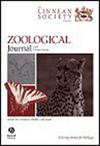双指卵盗龙Oksoko avarsan(兽脚亚目:卵盗龙科)的骨骼结构
IF 2.8
2区 生物学
Q1 ZOOLOGY
引用次数: 0
摘要
始祖鸟是最多样化和最著名的已灭绝兽脚类之一。它们奇异的解剖结构以及它们的社会和生殖行为现在已被人们充分了解。在卵翼龙亚支系中,两指的奥科阿瓦桑龙尤其具有代表性。它有几具精美的骨骼,不仅保存了整个骨骼,而且经历了本体发育的多个阶段,为了解卵龙类的解剖学及其骨骼在一生中所经历的变化提供了一个范例。在这里,我全面描述了 Oksoko avarsan 的骨骼结构,并对其本体变异进行了评论。标本保存完好,提供了无与伦比的卵翼龙解剖学细节,为解读其他卵翼龙提供了宝贵的背景资料。通过观察发现,卵龙的骨骼和骨架比例在个体发育过程中发生了一些变化,但几乎没有证据表明像颅嵴这样的离散特征是在个体发育后期出现的。相反,颅嵴在卵龙类中的早期发育,及其与鼻腔和其他气腔的内部联系,都证明了颅嵴在发声中的作用,或许与性展示一起发挥作用。详细的解剖学和个体发育数据,如已知的Oksoko avarsan标本所提供的数据,对于支持正在进行的卵翼龙类古生物学和宏观进化研究是非常必要的。本文章由计算机程序翻译,如有差异,请以英文原文为准。
Osteology of the two-fingered oviraptorid Oksoko avarsan (Theropoda: Oviraptorosauria)
Oviraptorosaurs are among the most diverse and best-known extinct theropod groups. Their bizarre anatomy and their social and reproductive behaviour are now well understood. Among the oviraptorid subclade, the two-fingered Oksoko avarsan is particularly well-represented. It is known from several exquisite skeletons, preserving not only the entire skeleton, but multiple stages through ontogeny, providing an exemplar for understanding the anatomy of oviraptorids and the changes that their skeletons experienced over their lifetimes. Here I comprehensively describe the osteology of Oksoko avarsan and comment on its ontogenetic variation. Excellent preservation of the specimens provides unparalleled detail into the anatomy of an oviraptorid, providing valuable context for interpreting other oviraptorosaurs. Several changes are observed to occur through ontogeny relating to robustness of the bones and proportions of the skeleton, but there is little evidence suggesting that discrete features like the cranial crest arose late in ontogeny. Instead, early development of the cranial crest in oviraptorids, and its internal connection with the nasal passages and other pneumatic spaces, argue in favour of a role in vocalization, perhaps alongside sexual display. Detailed anatomical and ontogenetic data, like those provided by known specimens of Oksoko avarsan, are necessary to help to underpin ongoing research into the palaeobiology and macroevolution of Oviraptorosauria.
求助全文
通过发布文献求助,成功后即可免费获取论文全文。
去求助
来源期刊
CiteScore
6.50
自引率
10.70%
发文量
116
审稿时长
6-12 weeks
期刊介绍:
The Zoological Journal of the Linnean Society publishes papers on systematic and evolutionary zoology and comparative, functional and other studies where relevant to these areas. Studies of extinct as well as living animals are included. Reviews are also published; these may be invited by the Editorial Board, but uninvited reviews may also be considered. The Zoological Journal also has a wide circulation amongst zoologists and although narrowly specialized papers are not excluded, potential authors should bear that readership in mind.

 求助内容:
求助内容: 应助结果提醒方式:
应助结果提醒方式:


